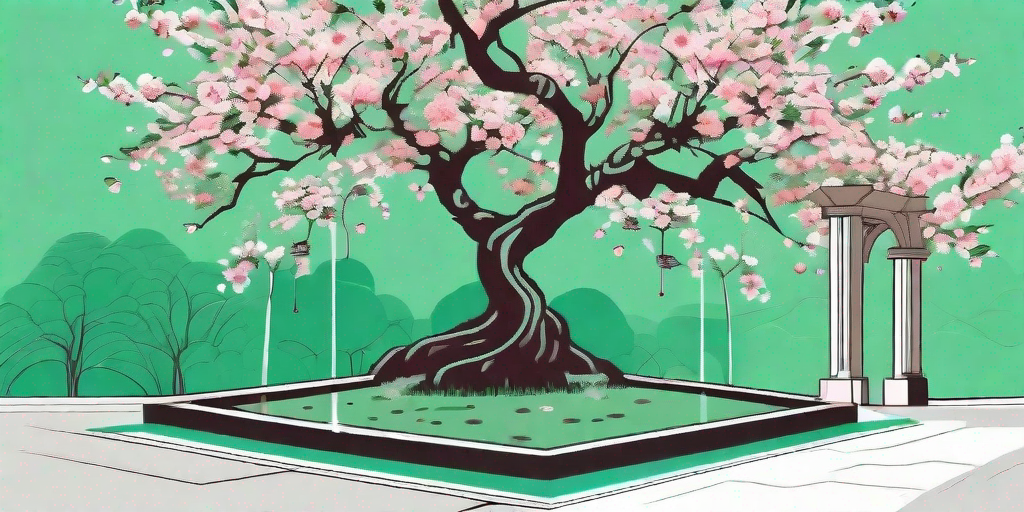
If you're looking for a way to sweeten up your garden, both literally and figuratively, then cherry trees might just be the answer. These delightful trees not only provide a feast for the eyes with their stunning blossoms, but also a feast for the palate with their delicious fruit. So, if you're ready to take your gardening game to the next level, let's dive into the world of cherry trees.
Understanding Cherry Trees
Before we get into the nitty-gritty of planting and caring for cherry trees, it's important to understand what they are. Cherry trees are part of the Prunus genus, which also includes plums, peaches, and almonds. There are two main types of cherry trees: sweet cherries (Prunus avium) and sour cherries (Prunus cerasus).
Sweet cherries are usually grown for their delicious fruit, which can be eaten right off the tree. These trees are larger and need more space to grow. Sour cherries, on the other hand, are smaller and more tolerant of cold weather. Their fruit is tart and is often used in cooking and baking.
The History of Cherry Trees
Cherry trees have a rich history that dates back thousands of years. They were first cultivated in the Near East around 3000 B.C., and were highly prized by the Greeks and Romans. In Japan, cherry trees, or "sakura," have been celebrated for centuries with annual cherry blossom festivals.
Today, cherry trees are grown all over the world, from Europe to North America to Asia. They are beloved not only for their fruit, but also for their beautiful blossoms, which are a sure sign of spring.
Planting Your Cherry Tree
Now that you're a cherry tree expert, it's time to get your hands dirty. Planting a cherry tree isn't as difficult as you might think, but it does require some planning and preparation.
First, you'll need to choose the right type of cherry tree for your climate and soil. Sweet cherries need a warm, sunny location with well-drained soil, while sour cherries can tolerate colder climates and heavier soils.
Choosing the Right Spot
Once you've chosen your tree, you'll need to find the perfect spot in your garden. Cherry trees need plenty of sun, so choose a location that gets at least six hours of sunlight each day. They also need good air circulation to prevent disease, so avoid planting them too close to buildings or other trees.
When it comes to soil, cherry trees aren't too picky. However, they do prefer a well-drained soil with a pH of 6.0 to 7.5. If your soil is heavy clay, you can improve drainage by adding organic matter or sand.
Planting Steps
Once you've chosen the perfect spot, it's time to plant. Here's a step-by-step guide:
- Dig a hole twice as wide and just as deep as the root ball.
- Place the tree in the hole, making sure the top of the root ball is level with the ground.
- Backfill the hole with soil, firming it gently around the roots.
- Water thoroughly, and keep the soil moist (but not soggy) for the first few weeks.
Caring for Your Cherry Tree
Once your cherry tree is planted, it's not time to sit back and relax just yet. Cherry trees need regular care to stay healthy and produce a good crop of fruit.
Watering is crucial, especially during dry spells. A good rule of thumb is to water deeply once a week during dry weather. Mulching around the base of the tree can help conserve moisture and suppress weeds.
Pruning and Fertilizing
Pruning is another important part of cherry tree care. Pruning helps to shape the tree, improve air circulation, and increase fruit production. It's best to prune in late winter or early spring, before the new growth starts.
When it comes to fertilizing, less is more. Too much fertilizer can lead to excessive leaf growth at the expense of fruit. A slow-release, balanced fertilizer applied in early spring is usually sufficient.
Harvesting and Enjoying Your Cherries
After all your hard work, it's time for the sweetest part: harvesting your cherries. Cherries are usually ready to harvest in late spring or early summer, depending on the variety and your climate.
Harvesting cherries is a delicate process, as they can bruise easily. It's best to pick cherries with the stem attached, and to store them in a shallow container to prevent bruising.
Using Your Cherries
Once you've harvested your cherries, the possibilities are endless. You can eat them fresh, bake them into pies or muffins, make cherry jam, or even brew cherry wine. Just be sure to enjoy them before the birds do!
FAQs About Cherry Trees
How long does it take for a cherry tree to bear fruit?
Most cherry trees will start bearing fruit 3 to 5 years after planting. However, some dwarf varieties can bear fruit in as little as 1 to 2 years.
Do I need two cherry trees to get fruit?
Some varieties of cherry trees are self-pollinating, which means they can produce fruit on their own. However, many varieties are not, and will need another cherry tree of a different variety nearby to cross-pollinate and produce fruit.
What pests and diseases affect cherry trees?
Cherry trees can be affected by a variety of pests and diseases, including aphids, cherry fruit flies, brown rot, and powdery mildew. Regular monitoring and early intervention can help keep these problems in check.
So there you have it, folks. The sweet, the sour, and the cherry on top. With a bit of care and patience, you can enjoy the fruits of your labor (pun intended) and add a touch of sweetness to your garden with a cherry tree. Happy gardening!











